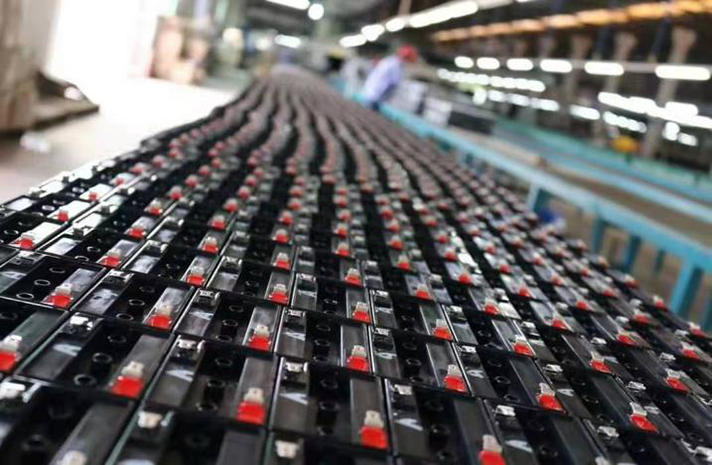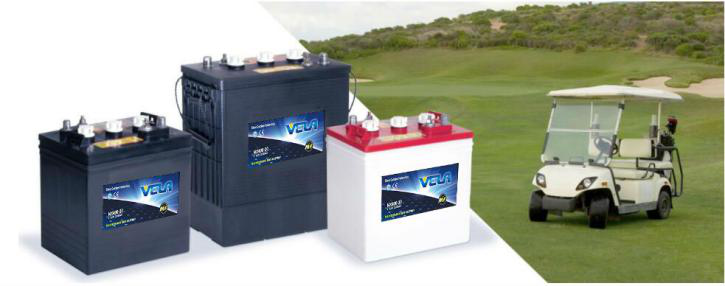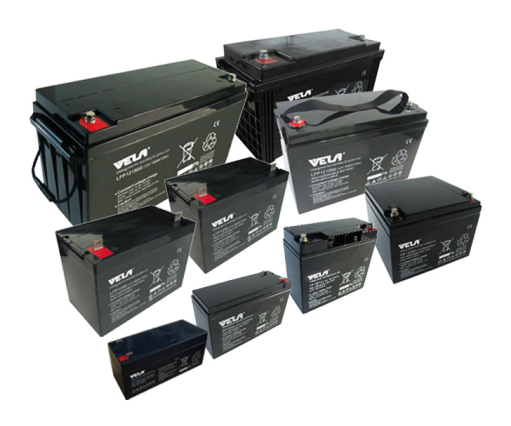
1. What is a deep cycle battery?
Deep cycle batteries (also called “solar batteries”) provide electricity storage in renewable energy (RE) systems. If you want to use electricity at any time other than when the system is in production, you need a battery. Therefore, if your solar panels generate a lot of electricity on a sunny day, you will need batteries to get electricity after the sun goes down. And, although this may seem counterintuitive, it is true, if your wind turbine or solar panel array is connected directly to the grid without batteries, you will not be able to use the electricity generated during a grid outage. If you need to use power at any time, you need a battery. But which one? The first thing to do is to determine the type of battery to be used in the system.
 2. Are deep cycle batteries different from car batteries?
The deep-cycle batteries used in renewable energy (RE) systems are different from car batteries, and this difference is crucial. Renewable energy systems are cyclical in nature: energy is captured and stored, and then (usually) consumed regularly. For example, in a battery-based solar power generation system, the energy generated by solar panels every day is stored in a battery pack and then used by loads at night or on less sunny days. This repeated process puts the battery in a slow daily charging and discharging mode.
Car batteries are not intended to be used in this way. They can immediately release a large amount of stored energy to start the engine, and then immediately obtain a fast charge from the car’s alternator. They are not meant to recover charge slowly like solar power systems. In fact, car batteries in renewable energy systems will quickly run out and need to be replaced. On the other hand, a deep-cycle battery can gradually discharge at half its capacity and wait patiently for the gradual charging. If properly maintained, deep-cycle batteries can last four to ten years.
3. Two Types of deep cycle batteries in renewable energy systems.
The deep cycle batteries used in renewable energy systems are divided into two parts. The division is flooded and sealed batteries. They all are lead-acid batteries. Sealed batteries include absorbent glass mat (AGM) batteries and gel batteries.
3.1 Subermerged/flooded lead-acid(FLA) deep cycle batteries
2. Are deep cycle batteries different from car batteries?
The deep-cycle batteries used in renewable energy (RE) systems are different from car batteries, and this difference is crucial. Renewable energy systems are cyclical in nature: energy is captured and stored, and then (usually) consumed regularly. For example, in a battery-based solar power generation system, the energy generated by solar panels every day is stored in a battery pack and then used by loads at night or on less sunny days. This repeated process puts the battery in a slow daily charging and discharging mode.
Car batteries are not intended to be used in this way. They can immediately release a large amount of stored energy to start the engine, and then immediately obtain a fast charge from the car’s alternator. They are not meant to recover charge slowly like solar power systems. In fact, car batteries in renewable energy systems will quickly run out and need to be replaced. On the other hand, a deep-cycle battery can gradually discharge at half its capacity and wait patiently for the gradual charging. If properly maintained, deep-cycle batteries can last four to ten years.
3. Two Types of deep cycle batteries in renewable energy systems.
The deep cycle batteries used in renewable energy systems are divided into two parts. The division is flooded and sealed batteries. They all are lead-acid batteries. Sealed batteries include absorbent glass mat (AGM) batteries and gel batteries.
3.1 Subermerged/flooded lead-acid(FLA) deep cycle batteries
 Submerged deep-cycle lead-acid batteries (FLA), also known as “wet batteries”, are often used in renewable energy systems such as solar, wind, and hydropower. They are usually the cheapest deep-cycle batteries and have the longest service life. They also come in various sizes.
In FLA batteries, the sulfuric acid solution reacts with the lead plates in the battery to produce electricity. When an FLA deep-cycle battery is charged, electrolysis occurs, producing hydrogen and oxygen in a normal process called “gassing”.These gases (hydrogen and oxygen) may escape the battery through the filler/vent cap, causing two problems: Liquid loss means a drop in the liquid level in the battery, which may cause “water flooding” under normal conditions It’s not a good thing that the lead plate of the company is exposed. So using FLA batteries in your system means you have to monitor and maintain them regularly, adding distilled water to each battery as needed.
3.2 Sealed deep cycle batteries
The biggest advantage of a sealed deep-cycle battery is that it can be placed in any orientation: upright, on its side, and sometimes even upside down. In sealed batteries, the electrolyte is suspended in an absorbent glass mat (AGM) or gel. Traditionally, gel batteries are more expensive than AGM batteries; however, they have a unique advantage in that they perform better in very cold temperatures or in very deep discharge applications, and they essentially require less maintenance. Because you cannot refill the electrolyte level.
Submerged deep-cycle lead-acid batteries (FLA), also known as “wet batteries”, are often used in renewable energy systems such as solar, wind, and hydropower. They are usually the cheapest deep-cycle batteries and have the longest service life. They also come in various sizes.
In FLA batteries, the sulfuric acid solution reacts with the lead plates in the battery to produce electricity. When an FLA deep-cycle battery is charged, electrolysis occurs, producing hydrogen and oxygen in a normal process called “gassing”.These gases (hydrogen and oxygen) may escape the battery through the filler/vent cap, causing two problems: Liquid loss means a drop in the liquid level in the battery, which may cause “water flooding” under normal conditions It’s not a good thing that the lead plate of the company is exposed. So using FLA batteries in your system means you have to monitor and maintain them regularly, adding distilled water to each battery as needed.
3.2 Sealed deep cycle batteries
The biggest advantage of a sealed deep-cycle battery is that it can be placed in any orientation: upright, on its side, and sometimes even upside down. In sealed batteries, the electrolyte is suspended in an absorbent glass mat (AGM) or gel. Traditionally, gel batteries are more expensive than AGM batteries; however, they have a unique advantage in that they perform better in very cold temperatures or in very deep discharge applications, and they essentially require less maintenance. Because you cannot refill the electrolyte level. 4. Flooded lead-acid(FLA) deep cycle batteries or Sealed deep cycle batteries? Which one is better?
The cost of sealed deep-cycle batteries is higher than that of submerged lead-acid batteries, and the charging cycle is not long; however, they are the first choice for applications that require frequent handling of batteries or where the system needs to be remotely unattended. Like FLA batteries, sealed batteries have vents to allow hydrogen to escape when necessary, although this should not normally happen. The difference is that because the battery is sealed, it is impossible to add water to the battery to replenish the escaped moisture; this is why the service life of the sealed battery is not as long as the FLA battery.
4. Flooded lead-acid(FLA) deep cycle batteries or Sealed deep cycle batteries? Which one is better?
The cost of sealed deep-cycle batteries is higher than that of submerged lead-acid batteries, and the charging cycle is not long; however, they are the first choice for applications that require frequent handling of batteries or where the system needs to be remotely unattended. Like FLA batteries, sealed batteries have vents to allow hydrogen to escape when necessary, although this should not normally happen. The difference is that because the battery is sealed, it is impossible to add water to the battery to replenish the escaped moisture; this is why the service life of the sealed battery is not as long as the FLA battery.
 2. Are deep cycle batteries different from car batteries?
The deep-cycle batteries used in renewable energy (RE) systems are different from car batteries, and this difference is crucial. Renewable energy systems are cyclical in nature: energy is captured and stored, and then (usually) consumed regularly. For example, in a battery-based solar power generation system, the energy generated by solar panels every day is stored in a battery pack and then used by loads at night or on less sunny days. This repeated process puts the battery in a slow daily charging and discharging mode.
Car batteries are not intended to be used in this way. They can immediately release a large amount of stored energy to start the engine, and then immediately obtain a fast charge from the car’s alternator. They are not meant to recover charge slowly like solar power systems. In fact, car batteries in renewable energy systems will quickly run out and need to be replaced. On the other hand, a deep-cycle battery can gradually discharge at half its capacity and wait patiently for the gradual charging. If properly maintained, deep-cycle batteries can last four to ten years.
3. Two Types of deep cycle batteries in renewable energy systems.
The deep cycle batteries used in renewable energy systems are divided into two parts. The division is flooded and sealed batteries. They all are lead-acid batteries. Sealed batteries include absorbent glass mat (AGM) batteries and gel batteries.
3.1 Subermerged/flooded lead-acid(FLA) deep cycle batteries
2. Are deep cycle batteries different from car batteries?
The deep-cycle batteries used in renewable energy (RE) systems are different from car batteries, and this difference is crucial. Renewable energy systems are cyclical in nature: energy is captured and stored, and then (usually) consumed regularly. For example, in a battery-based solar power generation system, the energy generated by solar panels every day is stored in a battery pack and then used by loads at night or on less sunny days. This repeated process puts the battery in a slow daily charging and discharging mode.
Car batteries are not intended to be used in this way. They can immediately release a large amount of stored energy to start the engine, and then immediately obtain a fast charge from the car’s alternator. They are not meant to recover charge slowly like solar power systems. In fact, car batteries in renewable energy systems will quickly run out and need to be replaced. On the other hand, a deep-cycle battery can gradually discharge at half its capacity and wait patiently for the gradual charging. If properly maintained, deep-cycle batteries can last four to ten years.
3. Two Types of deep cycle batteries in renewable energy systems.
The deep cycle batteries used in renewable energy systems are divided into two parts. The division is flooded and sealed batteries. They all are lead-acid batteries. Sealed batteries include absorbent glass mat (AGM) batteries and gel batteries.
3.1 Subermerged/flooded lead-acid(FLA) deep cycle batteries
 Submerged deep-cycle lead-acid batteries (FLA), also known as “wet batteries”, are often used in renewable energy systems such as solar, wind, and hydropower. They are usually the cheapest deep-cycle batteries and have the longest service life. They also come in various sizes.
In FLA batteries, the sulfuric acid solution reacts with the lead plates in the battery to produce electricity. When an FLA deep-cycle battery is charged, electrolysis occurs, producing hydrogen and oxygen in a normal process called “gassing”.These gases (hydrogen and oxygen) may escape the battery through the filler/vent cap, causing two problems: Liquid loss means a drop in the liquid level in the battery, which may cause “water flooding” under normal conditions It’s not a good thing that the lead plate of the company is exposed. So using FLA batteries in your system means you have to monitor and maintain them regularly, adding distilled water to each battery as needed.
3.2 Sealed deep cycle batteries
The biggest advantage of a sealed deep-cycle battery is that it can be placed in any orientation: upright, on its side, and sometimes even upside down. In sealed batteries, the electrolyte is suspended in an absorbent glass mat (AGM) or gel. Traditionally, gel batteries are more expensive than AGM batteries; however, they have a unique advantage in that they perform better in very cold temperatures or in very deep discharge applications, and they essentially require less maintenance. Because you cannot refill the electrolyte level.
Submerged deep-cycle lead-acid batteries (FLA), also known as “wet batteries”, are often used in renewable energy systems such as solar, wind, and hydropower. They are usually the cheapest deep-cycle batteries and have the longest service life. They also come in various sizes.
In FLA batteries, the sulfuric acid solution reacts with the lead plates in the battery to produce electricity. When an FLA deep-cycle battery is charged, electrolysis occurs, producing hydrogen and oxygen in a normal process called “gassing”.These gases (hydrogen and oxygen) may escape the battery through the filler/vent cap, causing two problems: Liquid loss means a drop in the liquid level in the battery, which may cause “water flooding” under normal conditions It’s not a good thing that the lead plate of the company is exposed. So using FLA batteries in your system means you have to monitor and maintain them regularly, adding distilled water to each battery as needed.
3.2 Sealed deep cycle batteries
The biggest advantage of a sealed deep-cycle battery is that it can be placed in any orientation: upright, on its side, and sometimes even upside down. In sealed batteries, the electrolyte is suspended in an absorbent glass mat (AGM) or gel. Traditionally, gel batteries are more expensive than AGM batteries; however, they have a unique advantage in that they perform better in very cold temperatures or in very deep discharge applications, and they essentially require less maintenance. Because you cannot refill the electrolyte level. 4. Flooded lead-acid(FLA) deep cycle batteries or Sealed deep cycle batteries? Which one is better?
The cost of sealed deep-cycle batteries is higher than that of submerged lead-acid batteries, and the charging cycle is not long; however, they are the first choice for applications that require frequent handling of batteries or where the system needs to be remotely unattended. Like FLA batteries, sealed batteries have vents to allow hydrogen to escape when necessary, although this should not normally happen. The difference is that because the battery is sealed, it is impossible to add water to the battery to replenish the escaped moisture; this is why the service life of the sealed battery is not as long as the FLA battery.
4. Flooded lead-acid(FLA) deep cycle batteries or Sealed deep cycle batteries? Which one is better?
The cost of sealed deep-cycle batteries is higher than that of submerged lead-acid batteries, and the charging cycle is not long; however, they are the first choice for applications that require frequent handling of batteries or where the system needs to be remotely unattended. Like FLA batteries, sealed batteries have vents to allow hydrogen to escape when necessary, although this should not normally happen. The difference is that because the battery is sealed, it is impossible to add water to the battery to replenish the escaped moisture; this is why the service life of the sealed battery is not as long as the FLA battery. 


